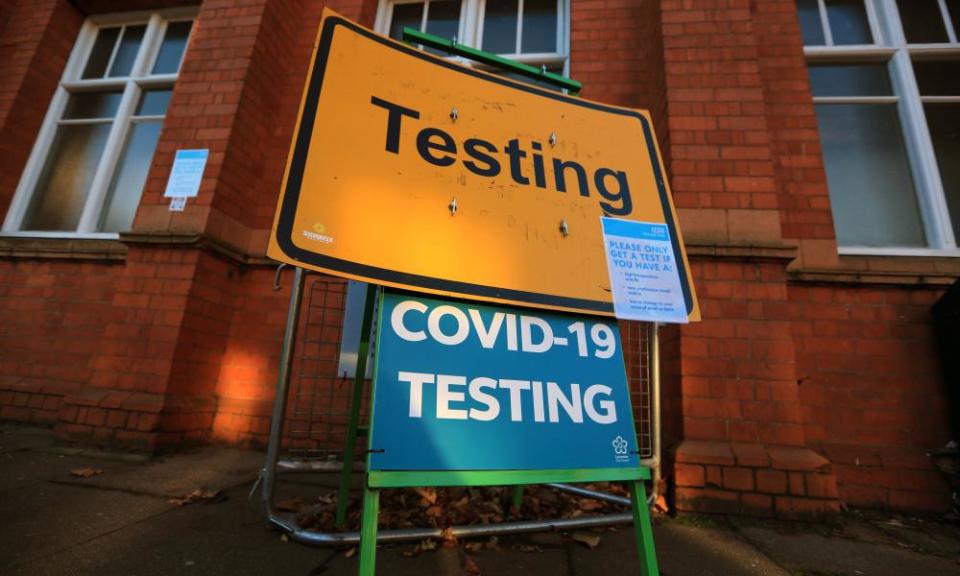Test and trace fails to contact 110,000 in English Covid hot spots

The government’s £22bn test-and-trace system has failed to reach more than 100,000 people exposed to coronavirus in England’s worst-hit areas since the second wave began, official figures show, with four in 10 not asked to self-isolate.
A Guardian analysis found that the privately run arm of the test-and-trace programme had reached 58% of the close contacts of infected people in the country’s 20 worst-hit areas since 9 September, having barely improved since its launch.
Boris Johnson defended the value of the struggling system in a Downing Street briefing on Monday after it received a further £7bn in funding, taking its cost to £22bn this year. This amounts to nearly a fifth of the NHS budget and about the same as the Department for Transport’s.
The health secretary, Matt Hancock, told MPs on Tuesday that test and trace “was functioning to reduce transmission enormously” and had “broken the chains of transmission hundreds of thousands of times” before England’s second national lockdown on 5 November.
However, official figures suggest its performance has waned as demand has increased. The proportion of close contacts being reached across England fell to its lowest level in October, to just over 60%.
In the areas with the highest infection rates, the private firms Serco and Sitel have reached 58% of exposed people since the start of the second wave, meaning the programme has barely improved on its 55% success rate in its first 11 weeks.
The government’s Scientific Advisory Group for Emergencies (Sage) has said that 80% of an infected person’s close contacts must be contacted and told to self-isolate within 48 to 72 hours for the national programme to be effective.
In total, 109,903 people in the worst-hit areas were not contacted when they should have been in the 11 weeks to 4 November, the Guardian has found, leaving them at risk of spreading the disease further.
Serco and Sitel were paid an initial £192m for the first three months of the programme, with the value of the contract reaching £730m over 12 months.
Alice Wiseman, the director of public health at Gateshead council, said she was concerned that the national system was failing to reach four in 10 potentially infectious people in the town. “It means there are more than 3,400 people out there potentially spreading the virus without knowing. It’s critical we get test and trace into a brilliant position for when we come out of lockdown,” she said.
Another director of public health said the low success rate of contact tracing had “undoubtedly contributed to our continuing high rates” of infection. There is also concern that the system will struggle to cope as rapid testing is rolled out to more parts of England from next week.
The Labour MP Justin Madders, a shadow health minister, said: “It has been clear for months now that the privately run parts of test and trace are failing badly and that the government have had ample time to fix or ditch the private providers.
“This second lockdown should have been used to finally resolve these problems but the time has been wasted and there is a huge risk that infections will spiral out of control again. It seems as if the government are almost in denial about the action needed.”
In Bradford, test and trace did not call 17,645 people who had been in close contact with an infected person – half of the number identified and by far the worst of the 20 worst-affected areas.
In Blackburn with Darwen, which has the UK’s highest per capita infection rate since the start of the pandemic, only 50% of close contacts have been reached during the second wave. In Leicester and Oldham, the figure is 53% and 54% respectively.
The analysis, which spans 9 September to 4 November, is based on figures released weekly by the Department of Health and Social Care (DHSC). It is not known how many of the 109,903 people were not reached due to a lack of contact details, as DHSC does not release this data by geography.
Susan Hinchcliffe, the leader of Bradford council, urged the government to allow local authorities to trace close contacts as well as those who have tested positive for coronavirus. Currently, councils are only given the power to trace infected people, not their close contacts.
“Naturally, I’m concerned by this because we need to make sure that everyone who might have the virus self-isolates because that’s the only way to get the virus down,” she said. “We all know that this system should have been designed with national and local working hand in hand.”
The Department of Health and Social Care said: “Contact tracing is working in every part of the country. The most recent weekly statistics show a record number of positive cases were transferred to contact tracers with 323,080 people reached and asked them to self-isolate - people who might otherwise have unknowingly spread the virus. In high outbreak areas such as the northwest we have reached almost 500,000 people. This is undoubtedly curbing the spread of Covid and saving lives.
“NHS Test and Trace has been boosted by the introduction of more than 150 Local tracing partnerships where councils are provided with extensive data and supported to manage local outbreaks, working closely with ring-fenced group of NHS contact tracers.”

 Yahoo Finance
Yahoo Finance 